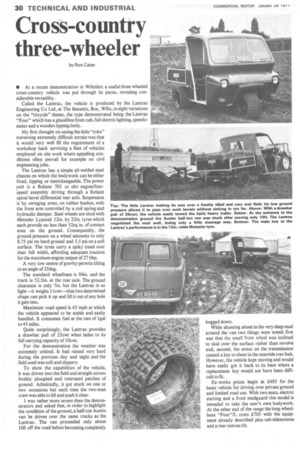Cross-country three-wheeler
Page 32

If you've noticed an error in this article please click here to report it so we can fix it.
by Ron Cater • At a recent demonstration in Wiltshire a useful three-wheeled cross-country vehicle was put through its paces, revealing considerable versatility.
Called the Lantrac, the vehicle is produced by the Lantrac Engineering Co Ltd, at The Bassetts, Box, Wilts, in eight variations on the "tricycle" theme, the type demonstrated being the Lantrac "Four" which has a glassfibre front cab, full electric lighting, speedometer and a wooden tipping body.
My first thought on seeing the little "trike" traversing extremely difficult terrain was that it would very well fill the requirement of a workshop hack servicing a fleet of vehicles employed on site work where appalling conditions often prevail for example on civil engineering jobs.
The Lantrac has a simple all-welded steel chassis on which the bodywork can be either fixed, tipping or interchangeable. The power unit is a Reliant 701 cc ohv engine/four
-speed assembly driving through a Reliant spiral-bevel differential rear axle. Suspension
is by swinging arms, on rubber bushes, with the front arm controlled by a coil spring and hydraulic damper. Steel wheels are shod with Metzeler Lypsoid 12in. by 22in. tyres which each provide no less than 52sq in. of contact area on the ground. Consequently, the ground pressure on a wheel amounts to only 8.75 psi on hard ground and 5.5 psi on a soft surface. The tyres carry a spiky tread over their full width, affording adequate traction for the maximum engine output of 27 bhp.
A very low centre of gravity permits tilting to an angle of 25deg.
The standard wheelbase is 84in. and the track is 52.5in. at the rear axle. The ground clearance is only 7in. but the Lantrac is so light—it weighs 11 cwt—that two determined chaps can pick it up and lift it out of any hole it gets into.
Maximum road speed is 45 mph at which the vehicle appeared to be stable and easily handled. It consumes fuel at the rate of lgal to 45 miles.
Quite surprisingly, the Lantrac provides a drawbar pull of 25cwt when laden to its full carrying capacity of 10ewt.
For the demonstration the weather was extremely unkind. It had rained very hard during the previous day and night and the field used was soft and slippery.
To show the capabilities of the vehicle, it was driven into the field and straight across freshly ploughed and rotavated patches of ground. Admittedly, it got stuck on one or two occasions but each time the two-man crew was able to lift and push it clear.
was rather more severe than the demonstrators and asked that, in order to highlight the condition of the ground, a half-ton Austin van be driven over the same tracks as the Lantrac. The van proceeded only about 10ft off the road before becoming completely bogged down.
While shunting about in the very deep mud around the van two things were noted; first was that the small front wheel was inclined to skid over the surface rather than revolve and, second, the stress on the transmission caused a key to shear in the nearside rear hub. However, the vehicle kept moving and would have easily got it back to its base where a replacement key would not have been difficult to fit.
Ex-works prices begin at £485 for the basic vehicle for driving over private ground and limited road use. With two seats, electric starting and a front mudguard this model is intended to take the user's own bodywork. At the other end of the range the long-wheelbase "Four"/L costs £705 with the equipment already described plus cab sidescreens and a rear canvas tilt.




























































































